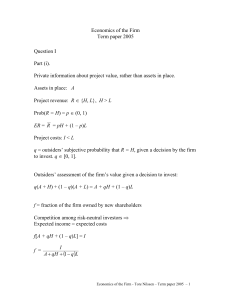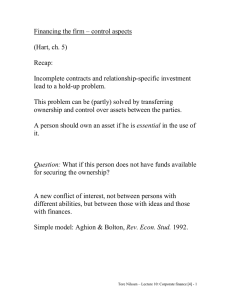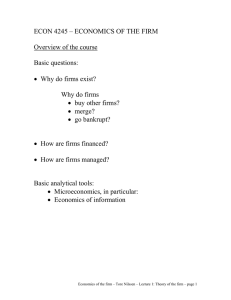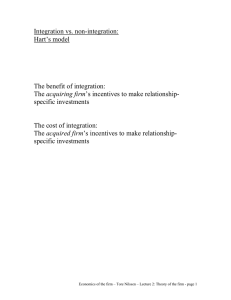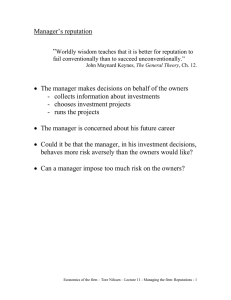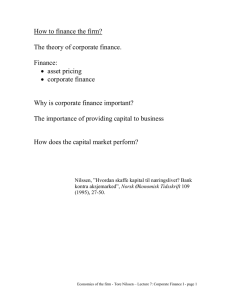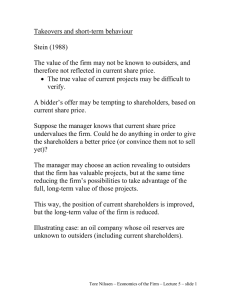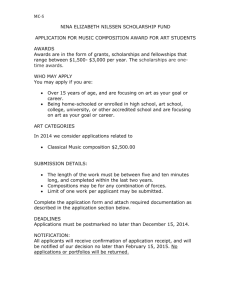Game theory and finance • Perfect competition: prices.
advertisement
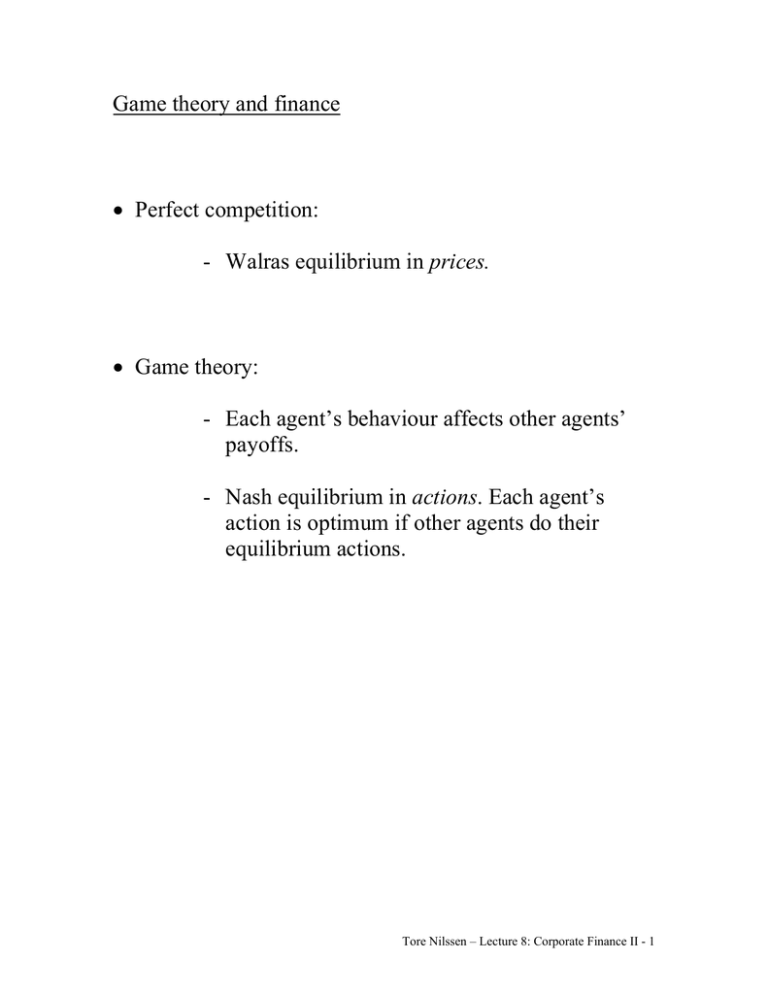
Game theory and finance
• Perfect competition:
- Walras equilibrium in prices.
• Game theory:
- Each agent’s behaviour affects other agents’
payoffs.
- Nash equilibrium in actions. Each agent’s
action is optimum if other agents do their
equilibrium actions.
Tore Nilssen – Lecture 8: Corporate Finance II - 1
Applying game theory to corporate finance:
• Uncertainty: Expected payoff
- Each player knows the uncertainty he faces
and the uncertainty each other player faces.
• Time: Sequential rationality
- Strategies versus actions:
strategy = ”plan of actions”
- Actions must be in equilibrium when they are
made.
- Think ahead. Reason back.
• Uncertainty and time
- One player’s action may affect other players’
beliefs.
- Perfect Bayesian Equilibrium: both strategies
and revised beliefs are in equilibrium.
- Given the strategies in equilibrium, which
revised beliefs are consistent with these
strategies?
- Given the way beliefs are revised in
equilibrium, which strategies are in
equilibrium?
Tore Nilssen – Lecture 8: Corporate Finance II - 2
Signalling game
Stage 1: The informed player chooses an action (signals)
Stage 2: The uninformed player observes the action chosen
at stage 1, revises his beliefs about the informed player, and
chooses himself an action.
The informed player’s private information – his type
• θ ∈ T = {High, Low}
The uninformed player’s beliefs about the other’s type:
• Pr(High) = pH, Pr(Low) = pL = 1 – pH
• stage 2: revised beliefs
Equilibrium: actions and revised beliefs
• Stage 1:
• Stage 2:
player 1’s action
player 2’s revised beliefs
player 2’s action
Tore Nilssen – Lecture 8: Corporate Finance II - 3
Hidden information
• Disregard conflicts of interest owners vs. management
• Focus on conflict of interest owners vs. outside investors
- insiders vs. outsiders
• The firm has private information
- the value of the firm (assets in place)
- the value of a new project
• The Pecking Order
- Myers & Majluf J Fin Econ 1984
- Internal funds > Debt > Equity
Tore Nilssen – Lecture 8: Corporate Finance II - 4
A simplified problem: Equity financing
New equity is an expensive source of financing because, in
the external capital market, high-value firms will have to
- either ”mingle” with low-value firms at a high
price
- or stay out of the capital market
- resorting to internal funds, or
- not invest
A model
(Daniel & Titman, without ”money burning”)
Value of the firm (assets in place): θ ∈ {H, L}, H > L.
The value of the firm is its private information.
Investors’ ex-ante beliefs:
Pr(θ = H) = p
Eθ = θ = pH + (1 – p)L
Project revenue: V
Project costs: I < V
Project value (NPV): V – I > 0.
Tore Nilssen – Lecture 8: Corporate Finance II - 5
Endogenous variables:
• The firm’s decision whether to invest, for each type θ.
• Outsiders’ revised beliefs, given observed decision:
q = outsiders’ subjective probability that θ = H,
given the firm’s decision (invest or not).
If the firm invests and outsiders have beliefs q, then
outsiders expect the firm’s value to become:
q(H + V) + (1 – q)(L + V) =
V + qH + (1 – q)L
Capital market is competitive.
Investors are risk neutral.
⇒ Investors’ expected revenue = expected costs
⇒ f[V + qH + (1 – q)L] = I,
where
f = share of the firm owned by new owners /
equity holders
⇒ f=
I
V + qH + (1 − q) L
• df/dq < 0
Tore Nilssen – Lecture 8: Corporate Finance II - 6
• Current owners are left with:
(1 – f)(θ + V),
θ ∈ {H, L}
Investment is profitable if:
(1 – f)(θ + V) ≥ θ ⇔
f≤
V
θ +V
Case (i): The firm has low value: θ = L
Investment is profitable if
V
I
≤
,
V + qH + (1 − q) L L + V
which always holds.
I < V, and V + qH + (1 – q)L ≥ V + L.
Thus: Low-value firms always invest.
Tore Nilssen – Lecture 8: Corporate Finance II - 7
Case (ii): The firm has high value: θ = H
Investment is profitable if
V
I
≤
⇔
V + qH + (1 − q) L H + V
q≥
I ( H +V ) −V ( L +V )
V ( H − L)
Consistency of beliefs:
(a) Since type L always invests, type H investing is
consistent with beliefs only if: q = p
Thus, an equilibrium exists in which
- the firm invests, whether it has a high value or
a low value, and
- q = p,
if:
p≥
I ( H +V ) −V ( L +V )
⇔
V ( H − L)
V H +V
≥
I θ +V
Tore Nilssen – Lecture 8: Corporate Finance II - 8
(b) Since type L always invests, type H not investing is
consistent with beliefs only if: q = 0
Investment is not profitable if
q≤
I ( H +V ) −V ( L +V )
V ( H − L)
An equilibrium exists in which
- the firm invests if and only if it has a low
value, and
- q = 0,
if:
I ( H +V ) −V ( L +V )
≥0 ⇔
V ( H − L)
V H +V
≤
I L +V
Tore Nilssen – Lecture 8: Corporate Finance II - 9
Conclusion
• Two equilibria
• Adverse selection when only type L invests.
V +H
V +θ
1
only type L
invests
V +H
V +L
both equilibria
are possible
V
I
both types
invest
Open questions
• Isn’t there anything a high-value firm can do in order to
convince investors about its true quality?
- ”money burning”
• What if we introduce debt financing as an alternative to
equity financing?
Tore Nilssen – Lecture 8: Corporate Finance II - 10
”Money burning”
What can a high-value firm do in order to convince outside
investors? – Waste money.
• Inflate investment costs.
• Deflate project value.
(a) Inflate investment costs? – No, doesn’t work.
(CHANGE? – consider taking this point (a) out)
• Can the firm ask for more funds from investors than I in
order to convince them that it is high-value?
- equity financed money burning
• Wasted money = C
Tore Nilssen – Lecture 8: Corporate Finance II - 11
• If this does work, then the high-value firm asks for I + C,
the low-value firm asks for I, and both types of firm
invest. Outside investors will only believe this if
- it is better for the low-value type not to pretend
being high value:
⎛
I
⎜
1
−
⎜⎜
L +V
⎝
C≥
⎞
⎟
⎟⎟ L +V
⎠
(
)≥
⎛
I +C
⎜
1
−
⎜⎜
H +V
⎝
⎞
⎟
⎟⎟ L +V
⎠
(
)
⇔
I (H − L)
L +V
- it is better for the high-type not to pretend being
low-value:
⎛
I +C
⎜
⎜1−
⎜
H +V
⎝
C≤
⎞
⎟⎛
⎞
⎟⎜⎝ H +V ⎟⎠
⎟
⎠
⎛
≥ ⎜⎜1−
⎜
⎝
I ⎞⎟⎛
⎞
⎟⎜⎝ H +V ⎟⎠ ⇔
L +V ⎟⎠
I (H − L)
L +V
• Both types indifferent at C = I(H – L)/(L + V).
• If the H-type asks for more money, so can also the Ltype ask for more. Thus, C has to be very high to
convince outsiders – actually, too high.
Tore Nilssen – Lecture 8: Corporate Finance II - 12
(b) Deflate project value? – Yes, might work.
• The firm may propose a project that is so ill-organized
that it will bring about a revenue of V – C instead of V.
• If this works, then the high-value firm presents a project
with value V – C, the low-value firm presents a project
with value V, and both types invest. Outside investors
believe this if:
- It is better for the low-value type not to pretend
being high value:
⎛
⎞
⎛
⎞⎟
I
⎜⎜1− I ⎟⎟( L + V ) ≥ ⎜⎜1−
⎟( L + V − C ) ⇔
⎜⎝ L + V ⎠⎟
⎝⎜ H + V − C ⎠⎟
L +V − C
C
+ ≥1 ⇔
H +V − C
I
C2 – (H + V)C + (H – L)I ≤ 0
The lowest C satisfying this condition is:
C*=
⎤
1 ⎡⎢
H +V − (H +V )2 − 4I (H − L )⎥
⎥⎦
2 ⎢⎣
Tore Nilssen – Lecture 8: Corporate Finance II - 13
- It is better for the high-type to invest with a
deflated project than not to invest:
⎛
⎞
I
⎜
⎟⎛
⎞
⎜1−
⎟⎜⎝ H +V −C ⎟⎠ ≥ H ⇔
⎜
H +V −C ⎟⎠
⎝
V–C≥I
(CHANGE – consider a third constraint: better for H type
to invest with deflated project than to invest with standard
project, being believed to be low-risk. This constraint
makes the second condition above redundant (is itself
redundant) if V/I > (<) (H + V)/(L + V), which is the the
critical value for underinvestment in the case aobe of no
money burning.)
• Deflated project value works as a signal of high value if:
C* ≤ V – I ⇔
(ψ)
(V – I)(H + I) – I(H – L) ≥ 0 ⇔
H −L ≤
(V − I )(H + I )
I
i.e., if the types are not too different.
We now have a separating equilibrium always:
•
If (ψ) holds, then both types invest and the Htype deflates its project’s value by C*.
Tore Nilssen – Lecture 8: Corporate Finance II - 14
•
If (ψ) does not hold, then only the L-type
invests.
In both kinds of equilibria, there are inefficiencies:
•
wasted resources, or
•
underinvestment.
Question: Is the firm able to commit to deflate the project’s
value after the investment capital has arrived?
Tore Nilssen – Lecture 8: Corporate Finance II - 15
What about debt vs. equity?
No uncertainty about project value ⇒
Debt without risk of loss, D = I.
⇒ Any project with V > I can be financed by debt.
A more realistic model:
• uncertainty in the firm’s value
→ equity financing costly
• uncertainty in the project’s value
→ debt financing costly
Tore Nilssen – Lecture 8: Corporate Finance II - 16
